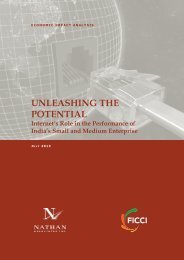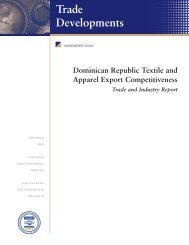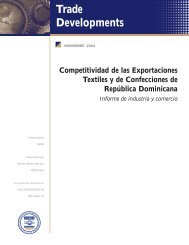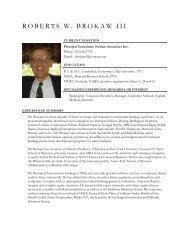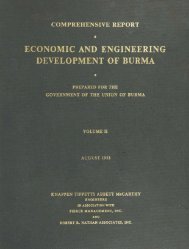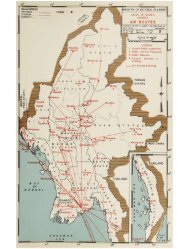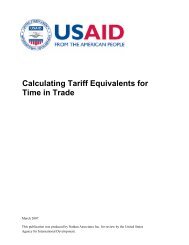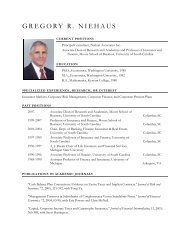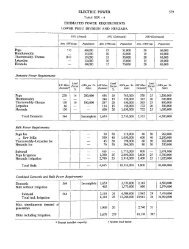Putting it to Work in Developing Countries - Nathan Associates
Putting it to Work in Developing Countries - Nathan Associates
Putting it to Work in Developing Countries - Nathan Associates
You also want an ePaper? Increase the reach of your titles
YUMPU automatically turns print PDFs into web optimized ePapers that Google loves.
ENDNOTES<br />
CHAPTER 1<br />
1 Un<strong>it</strong>ed Nations Conference on Trade and<br />
Development, World Investment Report 2006, p. 9.<br />
(Referred <strong>to</strong> hereafter as WIR 2006.)<br />
2 Alwyn Young, “The Tyranny of the Number:<br />
Confront<strong>in</strong>g the Real<strong>it</strong>ies of the East Asian Growth<br />
Experience,” Quarterly Journal of Economics, 110, no. 3<br />
(August 1995) is representative of the cap<strong>it</strong>al accumulation<br />
pos<strong>it</strong>ion. William Easterly’s The Elusive Quest for<br />
Growth, Economists’ Adventures and Misadventures <strong>in</strong> the<br />
Tropics (Cambridge, MA: MIT Press 2001) sets forth<br />
the <strong>to</strong>tal fac<strong>to</strong>r productiv<strong>it</strong>y side of the growth debate.<br />
Barry Bosworth and Susan M. Coll<strong>in</strong>s <strong>in</strong> “The<br />
Empirics of Growth: An Update,” [(Brook<strong>in</strong>gs<br />
Inst<strong>it</strong>ution, Wash<strong>in</strong>g<strong>to</strong>n D.C. 2003) (processed)]<br />
po<strong>in</strong>ts <strong>to</strong> a resolution of the discussion.<br />
3 Research suggests that the three private development<br />
f<strong>in</strong>ance flows are not correlated (e.g., there is no reason<br />
<strong>to</strong> believe that a country receiv<strong>in</strong>g high amounts of<br />
FDI is also receiv<strong>in</strong>g high amounts of loans). See Barry<br />
P. Bosworth and Susan M. Coll<strong>in</strong>s, 1999, “Cap<strong>it</strong>al<br />
Flows <strong>to</strong> Develop<strong>in</strong>g Economies: Implications for<br />
Sav<strong>in</strong>gs and Investment,” Brook<strong>in</strong>gs Papers on<br />
Economic Activ<strong>it</strong>y: 1, Brook<strong>in</strong>gs Inst<strong>it</strong>ution, pp.<br />
151–152.<br />
4 Data on FDI and other cap<strong>it</strong>al flows c<strong>it</strong>ed <strong>in</strong> this<br />
chapter are reported <strong>in</strong> World Bank, Global<br />
Development F<strong>in</strong>ance 2006 (referred <strong>to</strong> hereafter as<br />
GDF 2006) and the World Bank’s Global Development<br />
F<strong>in</strong>ance database (for years prior <strong>to</strong> 1998). GDF 2006<br />
<strong>to</strong>tals for FDI differ somewhat from data compiled by<br />
WIR 2006. Orders of magn<strong>it</strong>ude and trends are, however,<br />
consistent between World Bank and UNCTAD<br />
sources.<br />
5 Reported <strong>in</strong> International Monetary Fund, Foreign<br />
Direct Investment: Trends, Data Availabil<strong>it</strong>y, Concepts<br />
and Record<strong>in</strong>g Practices (Oc<strong>to</strong>ber 2004), p.3. Also established<br />
<strong>in</strong> Organization for Economic Co-operation and<br />
Development, Benchmark Def<strong>in</strong><strong>it</strong>ion of Foreign Direct<br />
Investment, Third Ed<strong>it</strong>ion, 1996.<br />
6 The economy <strong>in</strong> which the parent enterprise is resident<br />
is considered the “home country,” and the economy<br />
<strong>in</strong> which the foreign affiliate is resident is considered<br />
the “host country.”<br />
7 While UNCTAD and others gather statistics on<br />
cross-border M&A flows, no data exist on the annual<br />
value of greenfield FDI flows. Hence greenfield FDI is<br />
estimated here as a residual after subtract<strong>in</strong>g cross-border<br />
M&A from <strong>to</strong>tal recorded FDI <strong>in</strong>flows. But this<br />
residual does not encompass greenfield FDI alone: <strong>it</strong><br />
<strong>in</strong>cludes all other FDI flows that follow an <strong>in</strong><strong>it</strong>ial foreign<br />
<strong>in</strong>vestment by a parent enterprise, such as re<strong>in</strong>vested<br />
earn<strong>in</strong>gs <strong>in</strong> or <strong>in</strong>tracompany loans <strong>to</strong> <strong>it</strong>s foreign<br />
affiliate. Though not precise, these figures demonstrate<br />
that cross-border M&A appears <strong>to</strong> be the dom<strong>in</strong>ant<br />
FDI flow globally and <strong>in</strong> developed countries, while<br />
greenfield FDI is more important <strong>in</strong> the develop<strong>in</strong>g<br />
world.<br />
8 UNCTAD, WIR 2006, p.17.<br />
9 Ibid., pp. 16–21.<br />
10 World Bank, GDF 2004, pp. 86–90.<br />
11 In add<strong>it</strong>ion <strong>to</strong> volatil<strong>it</strong>y aris<strong>in</strong>g from economic cond<strong>it</strong>ions,<br />
host country and home country policies and<br />
regula<strong>to</strong>ry frameworks affect the compos<strong>it</strong>ion of FDI.<br />
Host country local ownership requirements that lim<strong>it</strong><br />
project participation by foreign equ<strong>it</strong>y or repatriation<br />
rules that constra<strong>in</strong> dividend flows both tend <strong>to</strong><br />
encourage <strong>in</strong>tracompany loans <strong>in</strong> parent-foreign affiliate<br />
f<strong>in</strong>anc<strong>in</strong>g flows. Home country tax policies that<br />
provide for tax deferrals until dividends from foreign<br />
affiliates are actually repatriated have the same effect.<br />
91



